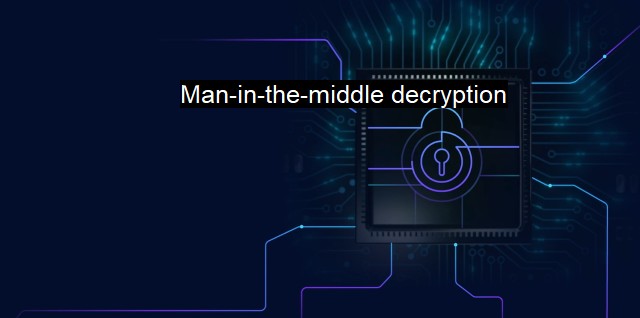What is Man-in-the-middle decryption?
How to Protect Against Man-in-the-Middle Decryption: Understanding Cyber Attack Tactics and Security Solutions
Man-in-the-middle decryption is a type of cyber-attack where the attacker intercepts and potentially alters the communication between two parties without their knowledge. The end goal of such an attack can range from stealing personal information or corporate data to inserting fraudulent messages into the communication chain. This kind of threat, characterized by surreptitious interception or tampering with confidential data, poses a significant challenge in the realm of cybersecurity.Cybersecurity refers to the protection of computer systems and networks from theft or damage to their hardware, software, or electronic data, as well as from the disruption or misdirection of the services they provide. Encryption is one of the primary defensive strategies used in cybersecurity. It involves encoding data so that only authorized individuals can access it, giving a strong line of defense against attackers. a man-in-the-middle decryption attack bypasses this often robust data encryption method by attacking the weak points in the communication lines.
Two users—let's call them A and B—may feel safe knowing their messages are encrypted. In a typical arrangement, A sends a message protected by secure encryption to B. On the receiving end, B has a special key used for decrypting the message; thus, the data remains safe from prying eyes during the transmission process.
That would be the case if we didn't consider potential man-in-the-middle attacks. In this scenario, an attacker, known as C, positions himself in the communication link. This arrangement allows C to receive the encrypted message before user B does. Interacting with user A as if he were B, C acquires decrypted information, exploiting information asymmetry and anonymity afforded to him in the digital medium.
The secrecy surrounding this phenomenon makes it exceptionally dangerous: A and B may operate under the belief they are still communicating securely, completely oblivious to the fact their supposedly confidential data has been compromised.
Recognizing its extreme risk to cybersecurity, antivirus software developers provision for man-in-the-middle decryption attacks. Antivirus software is a program designed to detect, prevent, and remove software viruses, and every other malicious software. Modern antivirus software has evolved into complex security systems, delivering tools not only against well-known and trending malware but also providing a broader scope of data protection, internet security, and personal firewalls.
Preventing man-in-the-middle decryption attacks requires techniques such as public-key infrastructure (PKI), transport-layer security (TLS), secure sockets layer (SSL), and some antivirus software. some cutting-edge firewalls now provide SSL Insight features that block man-in-the-middle attacks.
Users should consider keeping software and applications up-to-date to defend against new vulnerabilities. Regular security audits, user education about safe internet habits, using only reliable Wi-Fi networks, and prioritizing services that offer end-to-end encryption also play a significant role in preventing man-in-the-middle attacks.
Man-in-the-middle decryption amplifies the challenges faced by cybersecurity teams worldwide. Attackers pose as confidential recipients, intercept encrypted information, and potentially manipulate data—often without the original parties realizing the breach. To mitigate this, it's indispensable to seek robust encryption methods, bolster internal security policies, regularly update software, and utilize advanced antivirus software capable of countering these insidious attacks. The human element of cyber defenses is also quintessential—after all, the most technologically advanced systems still require discerning human oversight to ensure optimal protection.

Man-in-the-middle decryption FAQs
What is man-in-the-middle decryption?
Man-in-the-middle decryption is a cybersecurity attack in which an attacker intercepts communication between two parties and decrypts the information being exchanged. This attack can be used to steal sensitive information, such as passwords or financial data.How does man-in-the-middle decryption work?
Man-in-the-middle decryption works by intercepting the communication between two parties, typically by compromising a network or device. The attacker then uses this position to intercept the encrypted data being exchanged and decrypt it, allowing them to view the sensitive information being transmitted.How can I protect myself from man-in-the-middle decryption attacks?
To protect yourself from man-in-the-middle decryption attacks, it is important to use secure communication channels, such as SSL/TLS protocols. Additionally, you should ensure that your software and devices are up-to-date and running the latest security patches, and use strong passwords and multi-factor authentication where possible.How can antivirus software help prevent man-in-the-middle decryption attacks?
Antivirus software can help prevent man-in-the-middle decryption attacks by detecting and blocking suspicious network activity, as well as identifying and removing malware that may be used to carry out such attacks. It is important to keep your antivirus software up-to-date and to use a reputable software provider to ensure the highest level of protection.| | A | | | B | | | C | | | D | | | E | | | F | | | G | | | H | | | I | | | J | | | K | | | L | | | M | |
| | N | | | O | | | P | | | Q | | | R | | | S | | | T | | | U | | | V | | | W | | | X | | | Y | | | Z | |
| | 1 | | | 2 | | | 3 | | | 4 | | | 7 | | | 8 | | |||||||